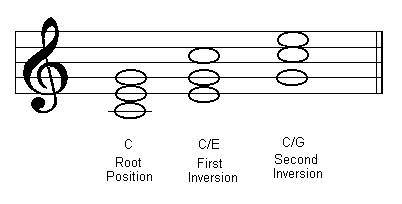
Triads do not have to be played with the notes always in the same order.
If the root note is the lowest note played (e.g. C in the case of a C major triad) this is known as a "root position triad" (or "a triad played in the root position"). Don't confuse the use of the word "position" here with anything to do with position on the guitar neck- it's being used here as a general music term.
If the 3rd (or flattened 3rd) degree of the triad is played as the lowest note (e.g. E in the case of a C major triad) this is known as the first inversion. If the 5th (or flattened/sharpened 5th) degree is played as the lowest note (e.g. G in the case of a C major triad) this is known as the second inversion. With a triad, that's as far as it can go - inverting the triad again gets back to the root position.
You can also denote inversions of 7th and extended chords with the 7th or extention in the bass by using the slash symbol. For example, the C7 chord contains the notes C-E-G-Bb, which if played with the b7 as the lowest note could be written as C7/Bb (i.e. a C major triad over a Bb bass note). The same chord played in the second inversion could be written as C7/G (i.e. a C7 chord played over a G bass note).
Using different chord inversions can allow you to use non-parallel chords voice leading to disguise the sameness of sound that might occur in progressions.
Any chord can be inverted.
How useful did you find this tutorial?